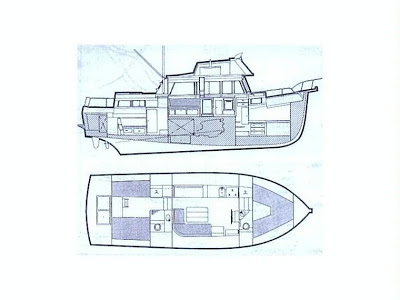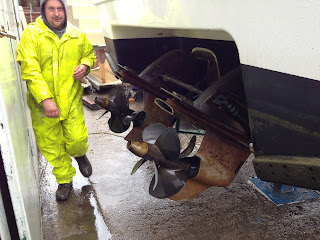Source: Eston Ellis, Sea Magazine.com
After 37 years, the Grand Banks 36 is still a classic
Lordy, lordy — look who’s close to 40.
Believe it or not, in just three years, Grand Banks will celebrate four decades as the world’s most popular trawler yacht builder. Almost since their introduction, Grand Banks yachts have turned heads and won over many a savvy boater.
This love affair began back in 1964, when Grand Banks first introduced three models — a 32, a 36 and a 42 — for the 1965 model year. The Grand Banks 36 Classic is still in production — and it remains incredibly popular. In Sea Magazine’s most recent survey of Western yacht brokers, it ranked as the second most popular trawler yacht overall — with the larger Grand Banks 42 in first place. While the 36 foot Grand Banks has long held “cult classic” status in the Pacific Northwest, it is riding a new wave of popularity everywhere, thanks to the growing worldwide demand for long-range trawler yachts.
Steeped in Tradition
With its distinctive teak-trimmed transom and rails, plumb bow, high bulwarks, large deckhouse and flying bridge, the 36 foot Grand Banks is a boat that has always had a traditional look — and for nine years, that traditional design was more than skin deep.
The first Grand Banks yachts were built in Hong Kong until 1968, when production was moved to Singapore. (Today, boats are built in both Singapore and Malaysia.) Known for traditional craftsmanship, flawless wood joinerwork and classic styling, Grand Banks did not switch from all-wood construction to contemporary fiberglass construction methods until 1973. When the builder made the move from Philippine mahogany to fiberglass, it did so without fanfare. In fact, Grand Banks made its fiberglass models look just like the wooden ones, with molded-in chines that look just like wood planking. Side by side, unless you already know the difference, it is impossible to tell that a well-maintained 1972 Grand Banks 36 is made of wood and a 1973 model is fiberglass. The acres of genuine teak trim and decking are the same on both versions. Only what’s beneath the white paint or gelcoat differs from model to model.
One thing that will instantly tell you a pre-1973 Grand Banks has a wood hull is its price tag. The oldest wood versions start at around $62,000 (depending on condition), while the oldest fiberglass 36s start at around $90,000 (and go all the way up to $450,000, for newer examples). The reason, of course, is that wood requires more maintenance. An unrestored 30-year-old Grand Banks may need to have some planking replaced, or at least have it through-bolted to its frames again. Neglected wooden 36s may have galvanic corrosion problems — or dry rot around the keel bolts, rudder posts, shaft logs and fuel fill ports. Not every marine surveyor or shipwright is experienced with wooden boats. It’s important to find professionals who are familiar with them, before you decide to buy a wood-hull boat of any make. That way, you’ll get a more accurate assessment of the boat’s actual condition and any potential maintenance issues that must be considered. Fortunately, Grand Banks owners are a proud lot and judging from what’s available on the used boat market, most of them seem to tackle their maintenance routines with near-religious fervour. With all the exterior teak on the 36 — even on the fiberglass models — that maintenance does require dedication.
Small or Just Right?
The 36 has been called a “right-size” boat for a couple, because it is so easy for two people to handle by themselves. Many long-range cruisers have a fondness for smaller boats, because it is easier to keep track of everything aboard, it’s easy to dock them and it’s more economical to run a small boat than a larger one — especially when you’re cruising hundreds of miles. However, the one onboard commodity no boater seems to have enough of is space — and that may be the 36’s one main shortcoming. That’s why the larger Grand Banks 42 is the West’s most popular trawler — and why the company now builds trawler yachts up to 64 feet. Still, the Grand Banks 36 has a surprisingly accommodating interior. There’s a large master stateroom aft, a single head compartment, a guest stateroom with V-berths forward and an airy saloon with an inside helm station (in addition to the station on the flybridge) and an adjacent galley. In 1988, Grand Banks gave the venerable 36 a subtle update, making the hull 6 inches longer and 4 inches wider. Several welcome improvements were added, including a stall shower in the boat’s aft head compartment and a walk-around queen-size berth in the aft stateroom (instead of twin berths). The bow pulpit was changed from teak to fiberglass.
Power to Cruise
Take one look at a Grand Banks 36, and you won’t expect it to win any on-the-water drag races. However, its semi-displacement hull is faster than you might think (thanks to a flattened aft section) and is quite sea kindly in even the sloppiest conditions (thanks to its deep draft, full keel and rub strakes that knock down spray). The first versions of the 36 came with a single, economical (but not very fast) 135 hp Lehman diesel inboard. The boat consumed just 3 gallons per hour at its 8 knot cruising speed, giving it a cruising range that approached 1,000 miles. Its top speed was around 12 knots. Later versions were available with a variety of larger, faster engine packages, including twin 210 hp Cummins diesels, to provide a 12 knot cruising speed and a top speed of around 15 knots. Whatever power package or hull type you choose, you’ll find that the Grand Banks 36 offers a great deal of practicality — whether you plan to do long-range cruising or close-to-home harbor hopping. The lines are timeless — and the resale values of used 36s remain remarkably high.
After 37 years, the Grand Banks 36 is still a classic
Lordy, lordy — look who’s close to 40.
Believe it or not, in just three years, Grand Banks will celebrate four decades as the world’s most popular trawler yacht builder. Almost since their introduction, Grand Banks yachts have turned heads and won over many a savvy boater.
This love affair began back in 1964, when Grand Banks first introduced three models — a 32, a 36 and a 42 — for the 1965 model year. The Grand Banks 36 Classic is still in production — and it remains incredibly popular. In Sea Magazine’s most recent survey of Western yacht brokers, it ranked as the second most popular trawler yacht overall — with the larger Grand Banks 42 in first place. While the 36 foot Grand Banks has long held “cult classic” status in the Pacific Northwest, it is riding a new wave of popularity everywhere, thanks to the growing worldwide demand for long-range trawler yachts.
Steeped in Tradition
With its distinctive teak-trimmed transom and rails, plumb bow, high bulwarks, large deckhouse and flying bridge, the 36 foot Grand Banks is a boat that has always had a traditional look — and for nine years, that traditional design was more than skin deep.
The first Grand Banks yachts were built in Hong Kong until 1968, when production was moved to Singapore. (Today, boats are built in both Singapore and Malaysia.) Known for traditional craftsmanship, flawless wood joinerwork and classic styling, Grand Banks did not switch from all-wood construction to contemporary fiberglass construction methods until 1973. When the builder made the move from Philippine mahogany to fiberglass, it did so without fanfare. In fact, Grand Banks made its fiberglass models look just like the wooden ones, with molded-in chines that look just like wood planking. Side by side, unless you already know the difference, it is impossible to tell that a well-maintained 1972 Grand Banks 36 is made of wood and a 1973 model is fiberglass. The acres of genuine teak trim and decking are the same on both versions. Only what’s beneath the white paint or gelcoat differs from model to model.
One thing that will instantly tell you a pre-1973 Grand Banks has a wood hull is its price tag. The oldest wood versions start at around $62,000 (depending on condition), while the oldest fiberglass 36s start at around $90,000 (and go all the way up to $450,000, for newer examples). The reason, of course, is that wood requires more maintenance. An unrestored 30-year-old Grand Banks may need to have some planking replaced, or at least have it through-bolted to its frames again. Neglected wooden 36s may have galvanic corrosion problems — or dry rot around the keel bolts, rudder posts, shaft logs and fuel fill ports. Not every marine surveyor or shipwright is experienced with wooden boats. It’s important to find professionals who are familiar with them, before you decide to buy a wood-hull boat of any make. That way, you’ll get a more accurate assessment of the boat’s actual condition and any potential maintenance issues that must be considered. Fortunately, Grand Banks owners are a proud lot and judging from what’s available on the used boat market, most of them seem to tackle their maintenance routines with near-religious fervour. With all the exterior teak on the 36 — even on the fiberglass models — that maintenance does require dedication.
Small or Just Right?
The 36 has been called a “right-size” boat for a couple, because it is so easy for two people to handle by themselves. Many long-range cruisers have a fondness for smaller boats, because it is easier to keep track of everything aboard, it’s easy to dock them and it’s more economical to run a small boat than a larger one — especially when you’re cruising hundreds of miles. However, the one onboard commodity no boater seems to have enough of is space — and that may be the 36’s one main shortcoming. That’s why the larger Grand Banks 42 is the West’s most popular trawler — and why the company now builds trawler yachts up to 64 feet. Still, the Grand Banks 36 has a surprisingly accommodating interior. There’s a large master stateroom aft, a single head compartment, a guest stateroom with V-berths forward and an airy saloon with an inside helm station (in addition to the station on the flybridge) and an adjacent galley. In 1988, Grand Banks gave the venerable 36 a subtle update, making the hull 6 inches longer and 4 inches wider. Several welcome improvements were added, including a stall shower in the boat’s aft head compartment and a walk-around queen-size berth in the aft stateroom (instead of twin berths). The bow pulpit was changed from teak to fiberglass.
Power to Cruise
Take one look at a Grand Banks 36, and you won’t expect it to win any on-the-water drag races. However, its semi-displacement hull is faster than you might think (thanks to a flattened aft section) and is quite sea kindly in even the sloppiest conditions (thanks to its deep draft, full keel and rub strakes that knock down spray). The first versions of the 36 came with a single, economical (but not very fast) 135 hp Lehman diesel inboard. The boat consumed just 3 gallons per hour at its 8 knot cruising speed, giving it a cruising range that approached 1,000 miles. Its top speed was around 12 knots. Later versions were available with a variety of larger, faster engine packages, including twin 210 hp Cummins diesels, to provide a 12 knot cruising speed and a top speed of around 15 knots. Whatever power package or hull type you choose, you’ll find that the Grand Banks 36 offers a great deal of practicality — whether you plan to do long-range cruising or close-to-home harbor hopping. The lines are timeless — and the resale values of used 36s remain remarkably high.
























